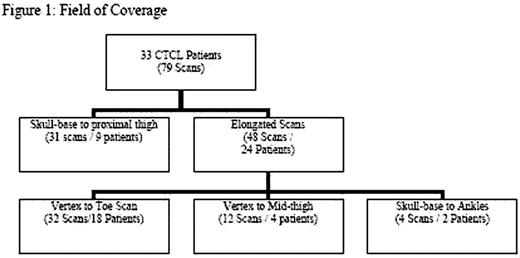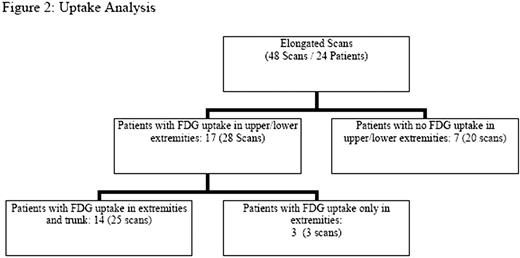Abstract
Abstract 5020
Positron emission tomography (PET) imaging using [F-18] fluorodeoxyglucose (FDG) provides metabolic information valuable to staging and restaging lymphoma patients. The Society of Nuclear Medicine recommends skull-base to proximal thigh imaging to survey the body and recommends vertex to toe PET/CT when the tumor may be in the extremities, e.g. melanoma (Delbeke 2006). As CTCL may develop in any region of the body, we aimed to assess the usefulness of vertex to toe PET/CT images in evaluating CTCL patients.
We retrospectively analyzed 79 PET/CT scans from 33 CTCL patients (15 men, 18 women, age range: 7-83, median: 56) who were imaged between 2004 and 2008. All studies were performed on GE Discovery LS 8 slice MDCT PET/CT scanner or GE Discovery DST 16 slice MDCT PET/CT scanner (Milwaukee, WI) and the images were interpreted on a GE AW or Xeleris workstation by four board certified nuclear medicine physicians.
The length distribution of the 79 scans is detailed in Figure 1. The 79 scans showed an average maximum SUV of 8.6 +/- 5.2 (range: 2.3 – 21.7). Of the 79 scans, 15 scans showed only cutaneous involvement; 25 scans showed lymph node involvement (as defined by radiologic criteria of lymph node > 1.5 cm, and SUV > 2.5); 10 scans showed likely benign, non-specific uptake in the lymph nodes; 8 scans showed hypermetabolic lymphadenopathy (as defined by SUV> 2.5, lymph node measurement <1.5 cm); 4 scans suggested organ involvement; and 18 scans showed no FDG uptake suggestive of malignancy, usually representing post-treatment patients. 71% of patients with elongated scans (17 of 24 patients) had FDG uptake suggestive of malignancy in areas of the body that would not have been imaged following the standard of skull-base to mid-thigh procedure. For 14 of these 17 patients, the elongated scans demonstrated systemic involvement which did not affect disease management, due to widespread uptake. However, in 3 patients, focal cutaneous uptake noted in the upper or lower extremities played a critical role in staging as there was no FDG uptake suggestive of malignancy in the skull-base to mid-thigh region. These results are demonstrated in Figure 2.
3 patients (13% of patients with at least one elongated scan) had FDG uptake only in the extremities. If these patients had been imaged from skull-base to proximal thigh, no suspicious FDG uptake would have been noted, and treatment plan may have been altered. Further studies prospective PET studies are necessary to determine its role in the staging and management of CTCL.
No relevant conflicts of interest to declare.
Author notes
Asterisk with author names denotes non-ASH members.



This feature is available to Subscribers Only
Sign In or Create an Account Close Modal